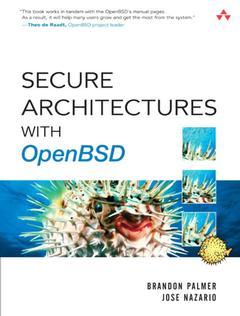Description
Secure architectures with OpenBSD
Authors: PALMER Brandon, NAZARIO José
Language: English
Subjects for Secure architectures with OpenBSD:
Approximative price 38.33 €
Subject to availability at the publisher.
Add to cart
Publication date: 06-2004
520 p. · 18x24 cm · Paperback
520 p. · 18x24 cm · Paperback
Description
/li>Contents
/li>
This book will become the de facto text for OpenBSD administration. Unix and BSD books abound, but none cover OpenBSD with the clarity and expertise of Palmer and Nazario. They explain the optimal way to configure and administer your OpenBSD machines, with a keen eye to security at all stages. Descended from BSD, OpenBSD is a popular choice for those who demand stability and security from their operating system. No code goes into OpenBSD without first undergoing a rigorous security check, making it a terrific choice for Web servers, VPNs, and firewalls. Secure Architectures with OpenBSD is the insider's guide to building secure systems using OpenBSD. Written by Brandon Palmer and Jose Nazario, this book is a how-to for system and network administrators who need to move to a more secure operating system and a reference for seasoned OpenBSD users who want to fully exploit every feature of the system. After getting readers started with OpenBSD, the authors explain system configuration and administration, then explore more exotic hardware and advanced topics. Every chapter of the book addresses the issue of security because security is integrated into almost every facet of OpenBSD. Examples appear throughout the book, and the authors provide source code and system details unavailable anywhere else. This goes well beyond the basics and gives readers information they will need long after they have installed the system. Key topic coverage includes: Installation and upgrade details, Basic system usage in OpenBSD versus other Unix systems, Third-party software via packages and the ports tree, SMTP services in OpenBSD, Web services with Apache, Using OpenBSD as a firewall, OpenBSD as a Kerberos V client and server, Use of Ipsec, Configuration and use of IPv6, Network intrusion detection.
1. Introduction.
What Will This Book Cover?
Who Is This Book For?
Book Syntax.
About the Authors.
Acknowledgments. I. GETTING STARTED.
2. Overview of OpenBSD.
A Brief History of OpenBSD.
OpenBSD Security.
Licensing.
The Feel of OpenBSD.
Packages and Ports.
Where Is OpenBSD Used?
3. Installation.
Supported Hardware.
System Preparation.
Getting the Files for Installation.
Selecting Boot Media.
Booting.
Filesystem Partitioning.
Network Configuration.
Base Software Set Installation.
Post Installation.
Customizing the Install Process.
Upgrading an Installation.
4. Basic Use.
General File System Layout.
Startup and Shutdown.
Logging In.
RC Scripts.
Default Processes.
Ports and Packages.
Networking in Brief.
APM Automatic Power Management.
Mouse Control with wsmoused.
5. Basic Default Services.
inetd The Super Server.
syslog The Logging Service.
Electronic Mail with sendmail.
The Secure Shell Server sshd.
6. Online Help Resources.
Manual Pages.
GNU Info Pages.
Perldoc and Pod.
Package Specific Documentation.
Other Sources.
7. X Window System.
Installation.
Quick Setup.
xdm.
Window Managers.
Basic X Applications.
Remote Display.
X and Security. II. SYSTEM CONFIGURATION AND ADMINISTRATION.
8. User Administration.
User Creation and Deletion.
vipw and Group Management.
User Limits with ulimit.
Process Accounting
Privileged Users with sudo.
Restricted Shells.
Restricting Users with Systrace.
9. Networking.
Device Support.
Basic Setup.
DNS Client Configuration.
DHCP.
Alias Addresses.
Address Resolution Protocol, ARP.
Routing.
Bridging.
PPP.
Listening Ports and Processes.
Troubleshooting.
10. inetd.
ftpd.
telnetd.
shell.
fingerd.
identd.
comsat.
ntalkd.
popa3d.
Internal Services.
Kerberos Services.
RPC Services.
11. Other Installed Services.
tftpd.
rarpd / bootparamd.
The Remote Shell.
Time Services.
Mouse services.
Printing.
dhcpd The DHCP Server.
12. Precompiled Third-Party Software: Packages.
An Overview of Packages.
Installation of Packages.
Uninstalling Packages.
Information About Installed Packages.
Third-Party Software and Security.
13. The Ports Tree: Third-Party Software from Source.
Ports.
Making Many Ports at Once.
Updating Specific Ports.
Troubleshooting.
14. Disks and Filesystems.
Disk Devices.

Network and System Security 59.52 €

Network and System Security 47.28 €
Filesystems.
Soft Updates.
Disklabels.
Mounting Filesystems 1.
Ps
© 2024 LAVOISIER S.A.S.
These books may interest you

Network and System Security 59.52 €

Network and System Security 47.28 €


